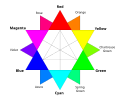| Mahogany | |
|---|---|
| | |
| Hex triplet | #C04000 |
| sRGB B (r, g, b) | (192, 64, 0) |
| HSV (h, s, v) | (20°, 100%, 75%) |
| CIELChuv (L, C, h) | (45, 111, 20°) |
| Source | Maerz and Paul [1] |
| ISCC–NBS descriptor | Strong yellowish brown |
| B: Normalized to [0–255] (byte) | |
Mahogany is a reddish-brown color. It is approximately the color of the wood mahogany. However, the wood itself, like most woods, is not uniformly the same color and is not recognized as a color by most.
Contents
- Variations of mahogany
- Mahogany red
- Mahogany brown
- Mahogany in media
- Video games
- See also
- Citations
- General and cited references
The first recorded use of mahogany as a color name in English was in 1737. [2]
